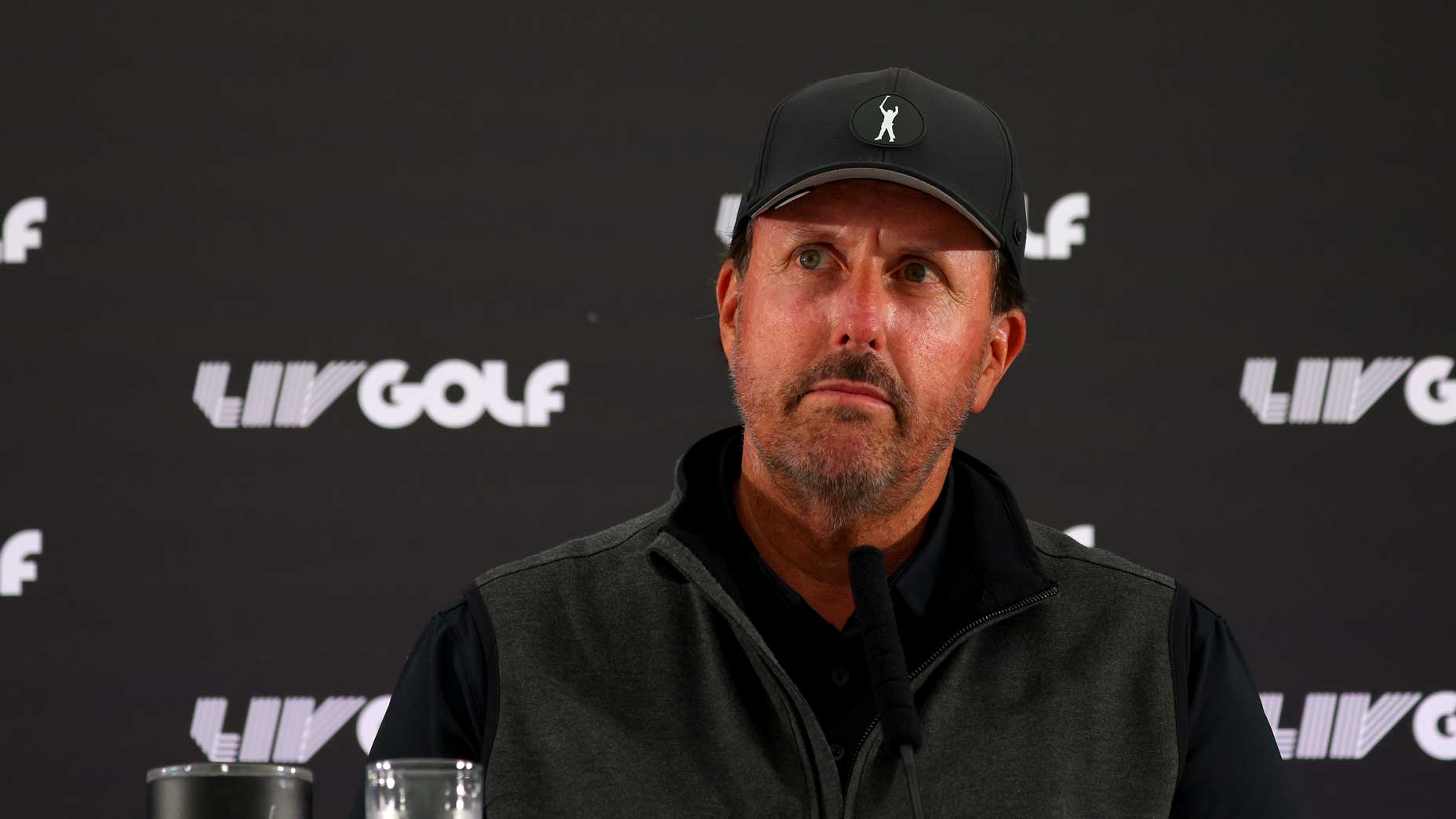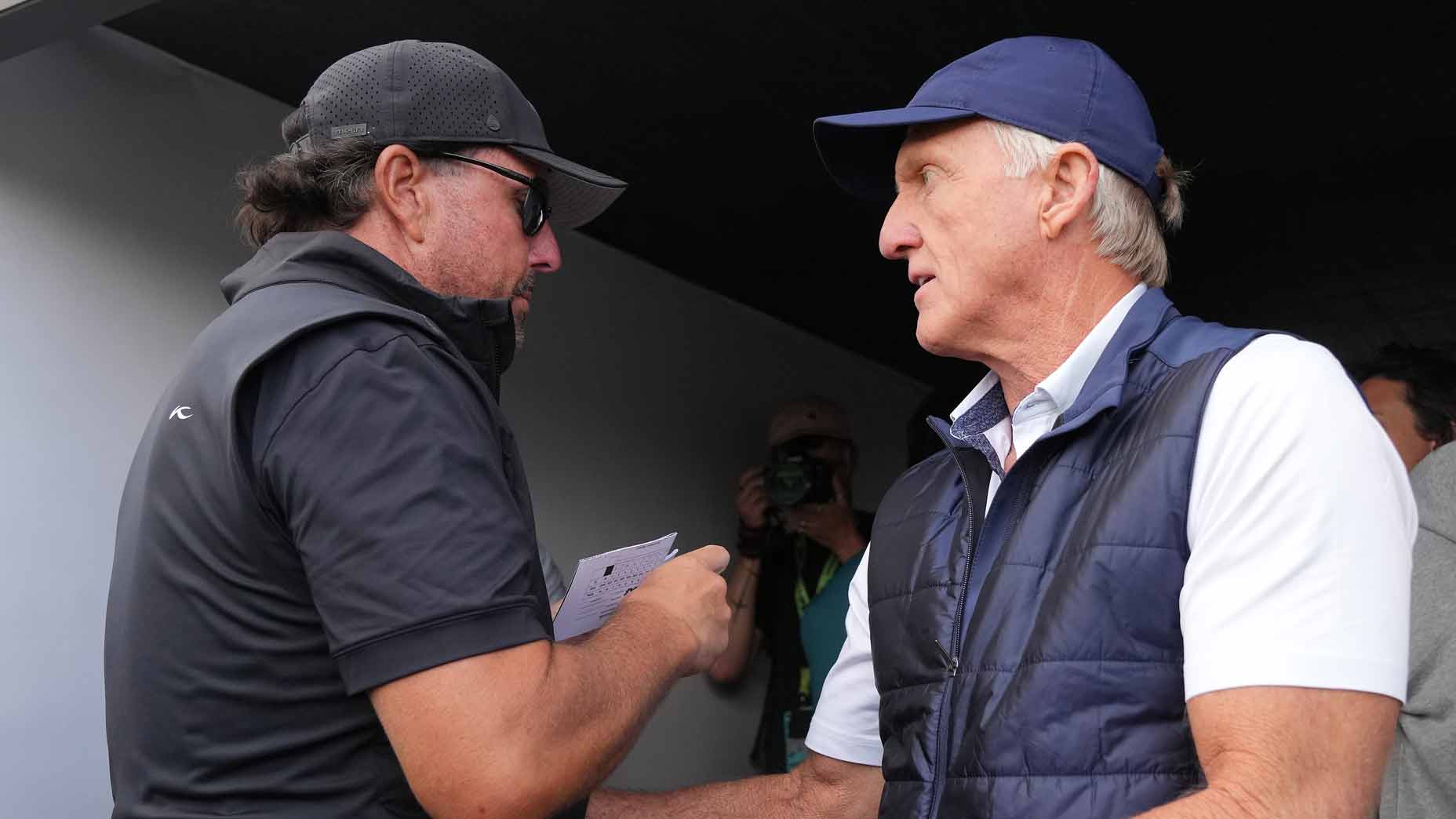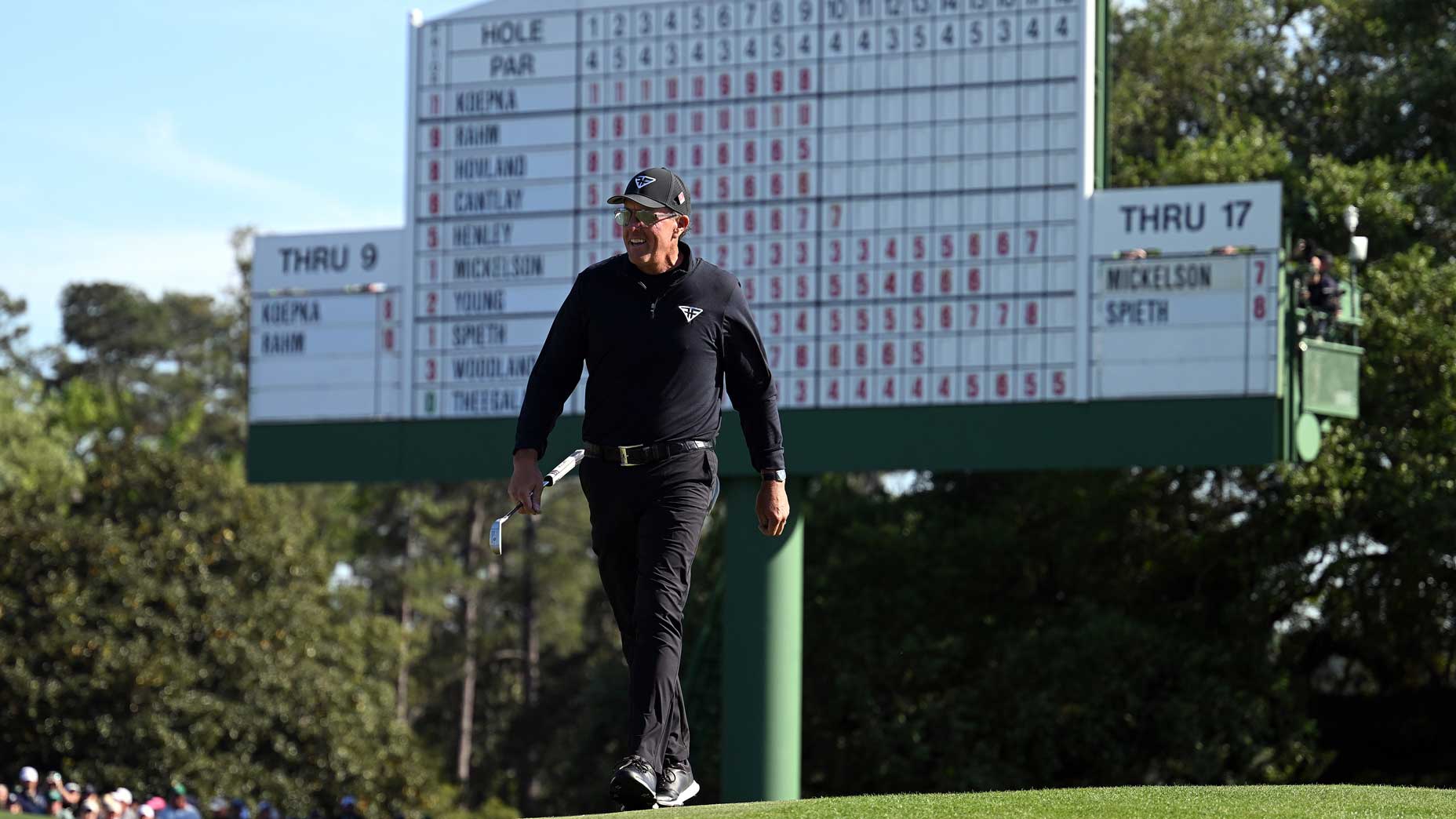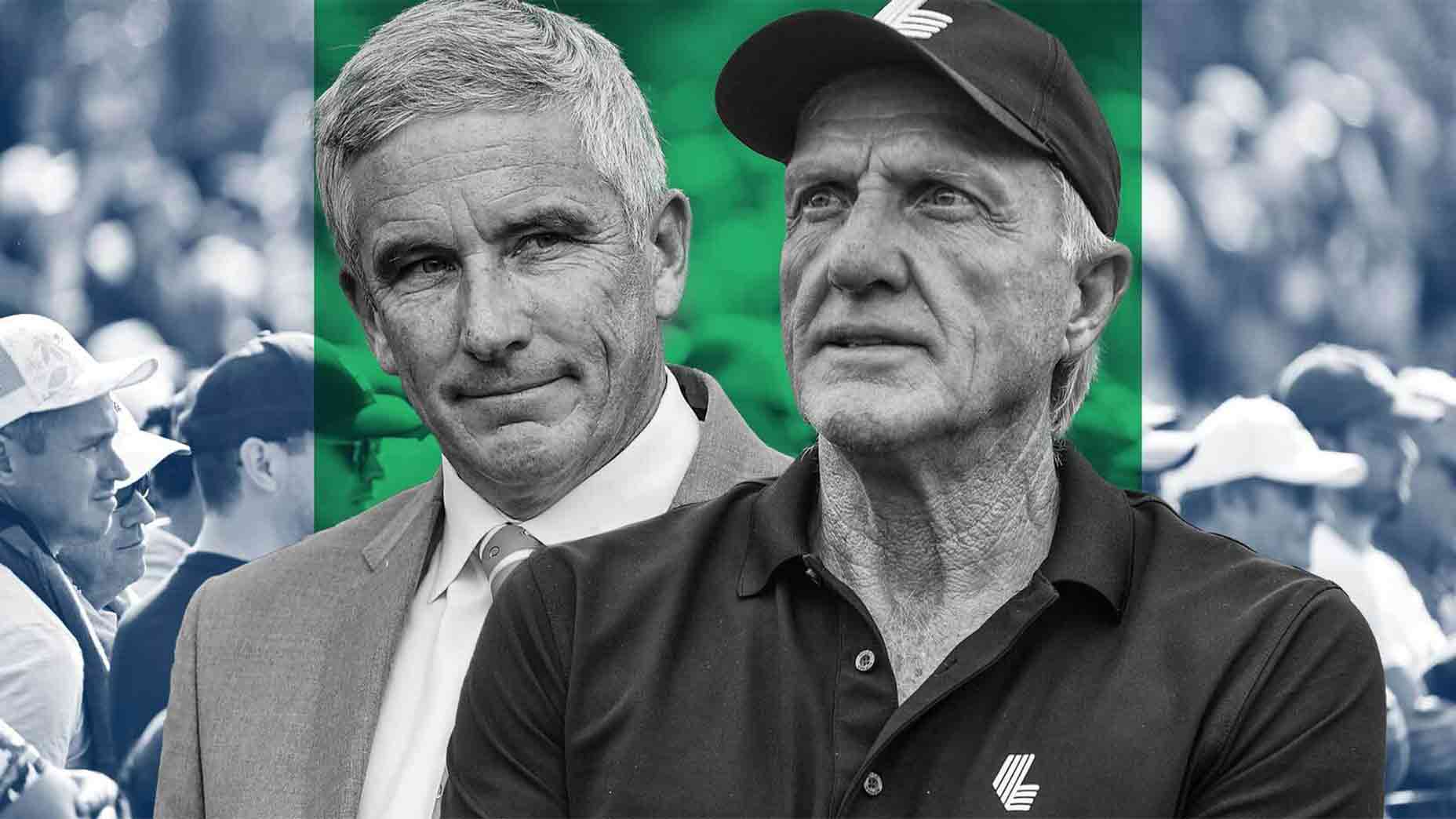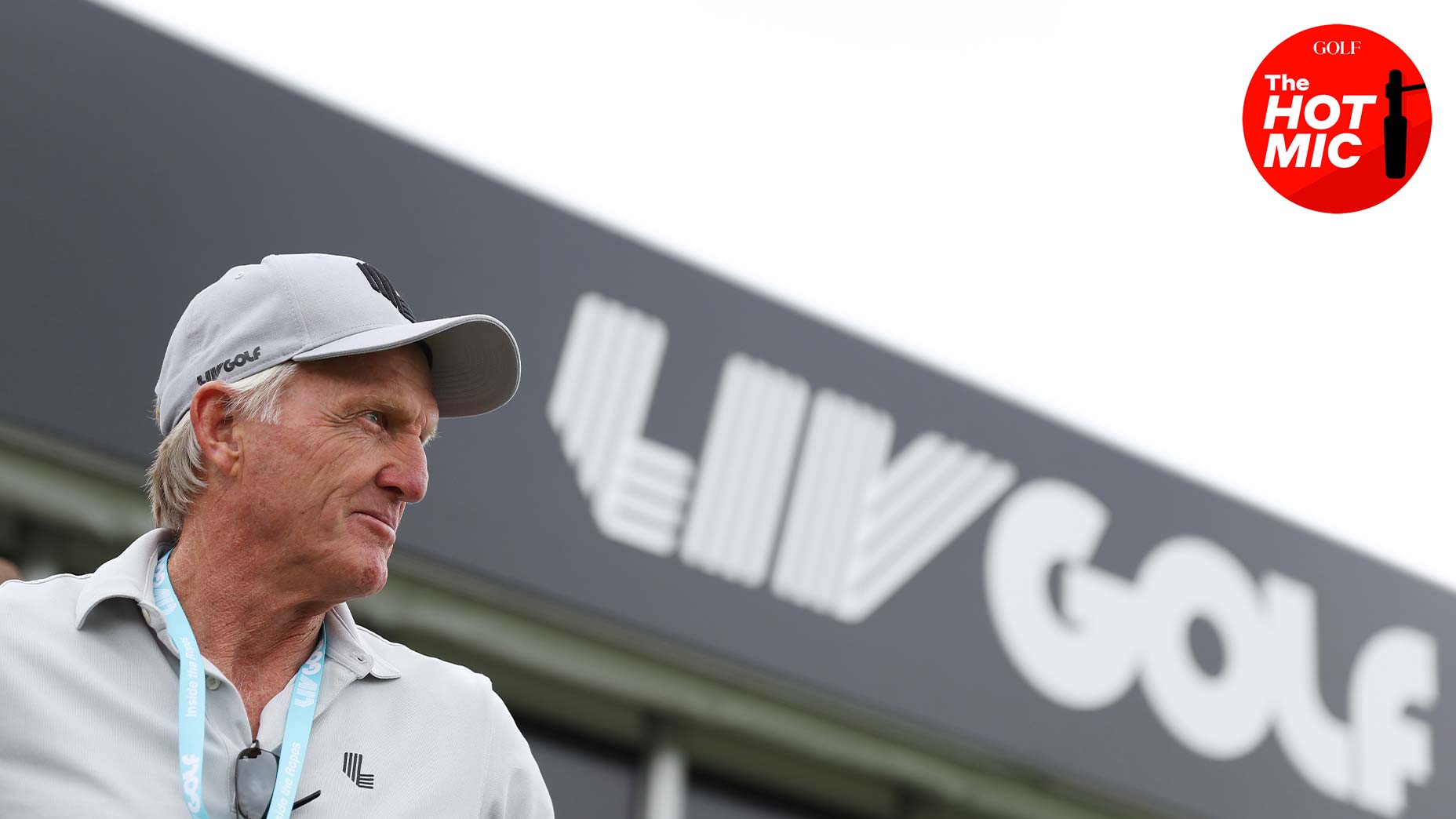ST. ALBANS, England — Before Phil Mickelson even said a word, it was clear that his Wednesday press conference at the maiden LIV Golf event would be different. When the 51-year-old arrived in the press room here at the posh Centurion Club, preparing to face the media for the first time since his controversial remarks about the upstart league turned his world upside down, he had just one logo on his person: his own — a silhouette of himself.
No Callaway, no Workday, no KPMG, or any of the other brands with which Mickelson has been associated in his 32-year professional career. He wore mostly black, with aviator sunglasses, and sported a trimmed beard. Though his three new teammates — Justin Harding, Ratchanon Chantananuwat and Chase Koepka — were seated at the dais beside him, every one of the first 26 questions were directed at and answered by Mickelson.
But that doesn’t mean he was his typical, expressive, outspoken self. The new Phil, who will play this week for the first time in more than four months, was calculated, bordering on tentative, in his answers ahead of the London-area event, the first in a series of LIV tournaments he will play this year. Above all, one thing was clear: his reluctance to discuss anything that pertains to the PGA Tour.
🗣️ "I understand people may disagree with my decision."
— Sky Sports Golf (@SkySportsGolf) June 8, 2022
Phil Mickelson speaks at the Centurion Club on his decision to play in the LIV Golf Series. pic.twitter.com/bgxcd6cd16
“I have really enjoyed my time on the PGA Tour,” he said. “I’ve had some incredible experiences, some great memories, and I have a lot of strong opinions on things that should and could be a lot better.
“One of the mistakes I’ve made is voicing those publicly. So I will really make an effort to keep those conversations behind closed doors going forward. I think that’s the way to be the most efficient and get the most out of it.”
Mickelson stayed true to form throughout, refusing to discuss the Tour on basically any level for the rest of the press conference. A moment later, when asked if he’s been banned, or is serving a suspension from the Tour, Mickelson was blunt: “I choose not to speak publicly on PGA Tour issues at this time.”
Seated next to his teammates — three students auditing Careful Answers 101 — Mickelson was methodical. He often paused after listening to a question, structuring his thoughts for five or six seconds before sharing them. He even interrupted a two-part question, asking that he receive just one question at a time. It was, both in transcript and in visual form, reminiscent of a deposition.
One of the topics that gave Mickelson great pause was the funding group behind the LIV Golf events, the Saudi Arabian government, and the label of “sportswashing” being applied to the entire series. Mickelson’s answer, each time, was curt and began with, “I do not condone human rights violations.”
“I’m certainly aware of what has happened with Jamal Kashoggi, and I think it’s terrible,” he said of the Washington Post journalist, who, in 2018, was assassinated by agents of the Saudi government, but refused to expound beyond that, often turning the attention back to the tournament he was representing.
LIV Golf updates: Suspensions, player rumors, media dust-ups as play begins in LondonBy: Dylan Dethier
Mickelson, as well as other players in the field, has received weeks of media training in the run-up to this event — and as recently as Tuesday night, 12 hours before he took the stage. When a reporter quickly followed up for comment about sportswashing, Mickelson remained evasive:
“I said earlier, I don’t condone human rights violations. I don’t know how I can be any more clear. I understand your question. But again I love this game of golf, I’ve seen the good that it’s done and I see the opportunity for LIV Golf to do a lot of good for the game throughout the world and I’m excited to be a part of the opportunity.”
Still, amid what was surely the most strained and awkward press conference of Mickelson’s career, there were occasional glimpses of the Phil of old. His wit and humor that long made him a media darling have not been completely zapped. He opened the presser with a joke about the “deep history” of this team (the Hy Flyers) that he assembled at the Tuesday-evening draft. At times, he flashed the sly grin that has come to define his public career.
But largely, Mickelson was somber, save for one topic: what he’s been up to for the last four months. During the Masters in April, which Mickelson said he voluntarily skipped, he skied each morning in Montana, tuning in for the tournament in the afternoon. He could have competed, he said, but was not ready to. “I found myself missing the Masters, but not wanting to be there.”
Same goes for the PGA Championship, in May, where he was the defending champion. “It was made clear to me through extensive conversations that I was able to play if I wanted to,” he said. “I wasn’t ready to play and compete.” Instead, Mickelson watched the golf on TV again. He has hiking in Sedona, Ariz., and attended his nephew’s Little League games. His niece’s lacrosse games, too. He says he’s spent the last four months attending therapy sessions and trying to create a healthier balance between his on- and off-course life.
And though he had a brief moment to enjoy himself discussing his leave of absence, more difficult questions followed, just as they will at his next start, the U.S. Open, outside Boston, next week. There was a question about his gambling issues, a problem which he said he has worked hard to address. There was a question about the reported sum of $200 million he was paid to play the LIV Golf series.
The only topic to which Mickelson added any real context was his status as a PGA Tour lifetime member. While Dustin Johnson and numerous other LIV-committed players have resigned their Tour memberships, Mickelson has not. “I’ve earned that, and I don’t plan on just giving it up,” he said. And yet, he knows that decision is not completely up to him. PGA Tour commissioner Jay Monahan has repeatedly threatened a lifetime ban for players participating in LIV events. He and Mickelson have not spoken, Mickelson said.
After 25 minutes, the press-room moderator said, “We’ve got time for one or two more questions. And just a gentle reminder, there are other golfers at the table.”
There may as well not have been. Three more Mickelson questions followed, and just one aimed at the group at large. Three minutes later, the press conference concluded.
Mickelson exited the room and headed to the practice area to prepare for a pro-am alongside Yasir Al-Rumayyan, the governor of Saudi’s public investment fund. His bag awaited him there. The Callaway logo that used to adorn the side of his bag had been replaced by another emblem: his own.
